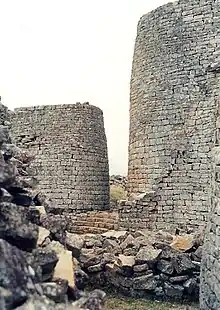Kingdom of Zimbabwe
The Kingdom of Zimbabwe (c. 1000–1450) was a medieval Shona (Karanga) kingdom located in modern-day Zimbabwe. Its capital, Lusvingo, now called Great Zimbabwe, is the largest stone structure in precolonial Southern Africa. This kingdom came about after the collapse of the Kingdom of Mapungubwe.
Kingdom of Zimbabwe Zimbabwe | |||||||||||
|---|---|---|---|---|---|---|---|---|---|---|---|
| 1220–1450 | |||||||||||
| Capital | Great Zimbabwe | ||||||||||
| Religion | Belief in Mwari | ||||||||||
| Government | Monarchy | ||||||||||
| Mambo | |||||||||||
| History | |||||||||||
• Abandonment of Mapungubwe for Zimbabwe | 1220 | ||||||||||
• Zimbabwe conquest of Mutapa | 1430 | ||||||||||
• Abandonment of Zimbabwe for Mutapa | 1450 | ||||||||||
| ISO 3166 code | ZW | ||||||||||
| |||||||||||

Part of a series on the |
||||||||||||||||||||||||||||||||||||||||
|---|---|---|---|---|---|---|---|---|---|---|---|---|---|---|---|---|---|---|---|---|---|---|---|---|---|---|---|---|---|---|---|---|---|---|---|---|---|---|---|---|
| History of Zimbabwe | ||||||||||||||||||||||||||||||||||||||||
Ancient history
|
||||||||||||||||||||||||||||||||||||||||
White settlement pre-1923
|
||||||||||||||||||||||||||||||||||||||||
Name
The name "Zimbabwe" stems from a Shona term for Great Zimbabwe, an ancient city in the country's south-east whose remains are now a protected site. Two different theories address the origin of the word. Many sources hold that "Zimbabwe" derives from dzimba-dza-mabwe, translated from the Karanga dialect of Shona as "houses of stones" (dzimba = plural of imba, "house"; mabwe = plural of bwe, "stone").[1][2][3] The Karanga-speaking Shona people live around Great Zimbabwe in the modern-day province of Masvingo. Archaeologist Peter Garlake claims that "Zimbabwe" represents a contracted form of dzimba-hwe, which means "venerated houses" in the Zezuru dialect of Shona and usually references chiefs' houses or graves.[4]
Origin
Although the Kingdom of Zimbabwe was formally established during the medieval period, archaeological excavations in the region suggest that state formation here was considerably more ancient. Earlier theories suggested that in the early 11th century, people from the Kingdom of Mapungubwe in Southern Africa moved north into the Great Zimbabwe area. Newer research and evidence shows the Great Zimbabwe site had been occupied as early as 600AD and that the city and Kingdom were an evolution of the Gumanye and Gokomere cultures, some of which are still in existence today.
Culture and expansion
The rulers of Zimbabwe brought artistic and stonemasonry traditions from Mapungubwe. The construction of elaborate stone buildings and walls reached its apex in the kingdom. The institution of mambo was also used in Zimbabwe, along with an increasingly rigid three-tiered class structure. The kingdom taxed other rulers throughout the region. The kingdom was composed of over 150 tributaries headquartered in their own minor zimbabwes.[5] They established rule over a wider area than the Mapungubwe, the Butua or the Mutapa.
Economy
The Kingdom of Zimbabwe controlled the ivory and gold trade from the interior to the southeastern coast of Africa. Asian and Arabic goods could be found in abundance in the kingdom. Economic domestication, which had been crucial to the earlier proto-Shona states, was also practiced. The Great Zimbabwe people mined minerals like gold, copper and iron. They also kept livestock, as it is explained by its theory of cattle hypothesis.
Rise of Mutapa and decline of Zimbabwe
In approximately 1430 Prince Nyatsimba Mutota from the Great Zimbabwe travelled north to the Dande region in search of salt. He then defeated the Tonga and Tavara with his army and established his dynasty at Chitakochangonya Hill. The land he conquered would become the Kingdom of Mutapa. Within a generation, Mutapa eclipsed Great Zimbabwe as the economic and political power in Zimbabwe. By 1450, the capital and most of the kingdom had been abandoned.
Aftermath
The end of the kingdom resulted in a fragmenting of proto-Shona power. Two bases emerged along a north-south axis. In the north, the Kingdom of Mutapa carried on and even improved upon Zimbabwe's administrative structure. It did not carry on the stone-masonry tradition to the extent of its predecessor. In the south, the Kingdom of Butua was established as a smaller, but nearly identical, version of Zimbabwe. Both states were eventually absorbed into the largest and most powerful of the Shona states, the Rozwi Empire.
See also
References
- "Zimbabwe – big house of stone". Somali Press. Archived from the original on 3 May 2011. Retrieved 14 December 2008.
- Lafon, Michel (1994). "Shona Class 5 revisited: a case against *ri as Class 5 nominal prefix" (PDF). Zambezia. 21: 51–80.
- Vale, Lawrence J. (1999). "Mediated monuments and national identity". Journal of Architecture. 4 (4): 391–408. doi:10.1080/136023699373774.
- Garlake, Peter (1973). Great Zimbabwe: New Aspects of Archaeology. London, UK: Thames & Hudson. p. 13. ISBN 978-0-8128-1599-3.
- Owomoyela 2002, p. 7.
Sources
- Peters, Carl (1902). The Eldorado of the Ancients. London: C. Arthur Pearson.
- Griffith, Francis Llewellyn (1903). Archæological Report. Egypt Exploration Fund.
- Böhmer-Bauer, Kunigunde (2000). Great Zimbabwe: eine ethnologische Untersuchung. R. Köppe. ISBN 389645210X.
- Oliver, Roland & Anthony Atmore (1975). Medieval Africa 1250–1800. Cambridge: Cambridge University Press. pp. 738. ISBN 0-521-20413-5.
- Owomoyela, Oyekan (2002). Culture and Customs of Zimbabwe. Westport: Greenwood. ISBN 978-0-313-31583-1.
- Stewart, John (1989). African States and Rulers. Jefferson: McFarland. pp. 395. ISBN 0-89950-390-X.
- Wieschhoff, H. A. (2006). The Zimbabwe-Monomotapa Culture in Southeast Africa. Whitefish: Kessinger. p. 116. ISBN 1-4286-5488-7.
